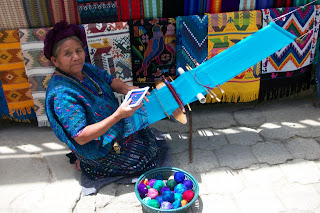Lake Atitlan
I’ve just returned from Guatemala, a beautiful country of forested volcanic mountains, sinuous rivers, and lakes. All of the Guatemalan people I met were friendly and courteous. I did not get off the tourist track, spending most of my time on the slopes of Lake Atitlan and then briefly visiting Guatemala Antigua. However, these two struck me as symbolically important locations. Lake Atitlan lies in Mayan territory, while Antigua is the old Spanish colonial capital of Central America. These represent, then, the two formative populations of Guatemala, the ancient Mayan base and the Spanish elite.
A Mayan Weaver of San Pablo, on the Banks of Atitlan
The Arch in Guatemala Antigua
In the Atitlan region, I was impressed by the extent to which the Mayans have maintained their cultural identity. The designs in the elegant handmade clothes still worn by nearly all of the girls and women identify them with each of their villages. One occasionally also sees men in traditional localized dress, although the men have moved more toward the modern universal style. I’ve noticed elsewhere in the world that women retain culturally specific clothing much more than men do. I this is probably due to the human tendency to see women as more fundamental than men to social continuity, since women, as mothers, connect every group’s past to its future. The Mayans have also kept their languages. While most can speak Spanish fluently, in traveling around the lake on public boats I kept hearing people talk to each other in tongues that were unintelligible to me and sounded nothing like any Romance language.
The Central Park in Antigua
I am no authority on Guatemalan history, but I see the Guatemalan civil war that raged during the 1980s as at least in part a clash between the goals of the two population groups. The mainly Spanish rulers of the country wanted to modernize the country and they saw the unassimilated Mayans as impediments to this goal. The Mayans, on the other hand, wanted to be allowed to continue their own way of life. One of the great ironies of the war, in my relatively uninformed impression, was the way this conflict between modernity and tradition became part of the worldwide Cold War. Marxist-inspired leftists, as government opponents, allied themselves with the Mayan side, so that there was a Communist versus anti-Communist dimension to the struggle, inspiring some support for the Guatemalan government from the U.S. foreign policy establishment. The reason I say that this was ironic was that Mayan traditionalist resistance to forced progressive modernization became affiliated with Marxism, the ultimate ideology of anti-traditionalist coercive progressivism.





No comments:
Post a Comment